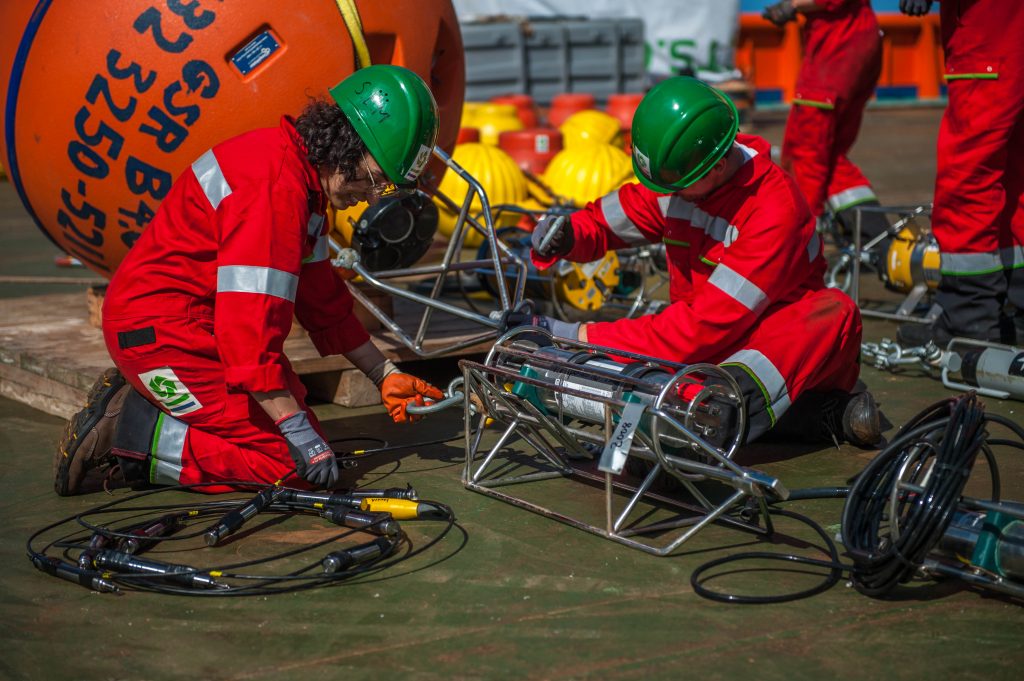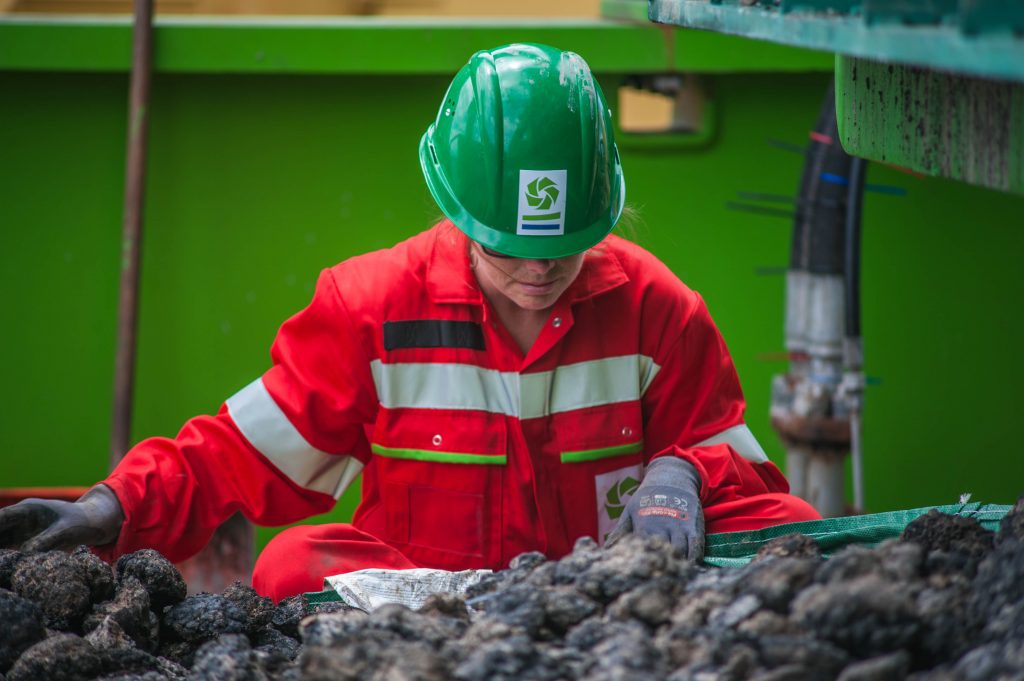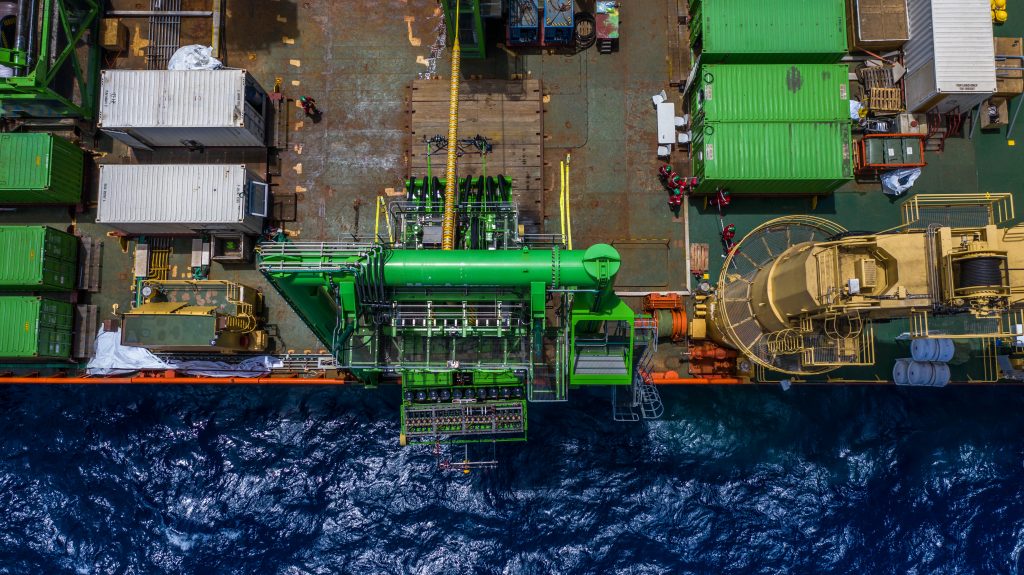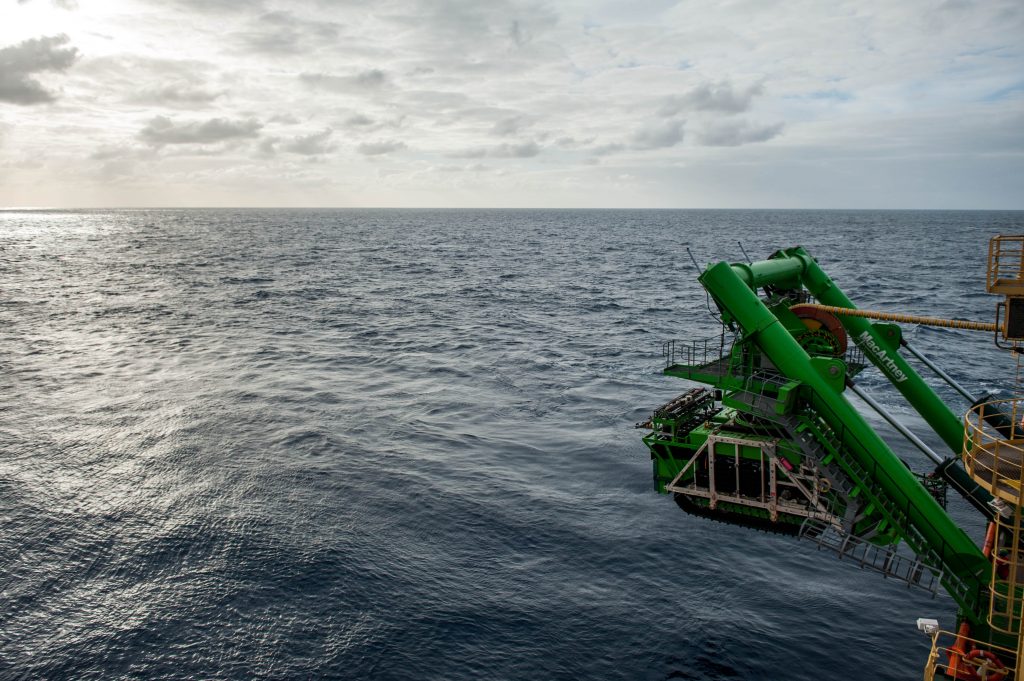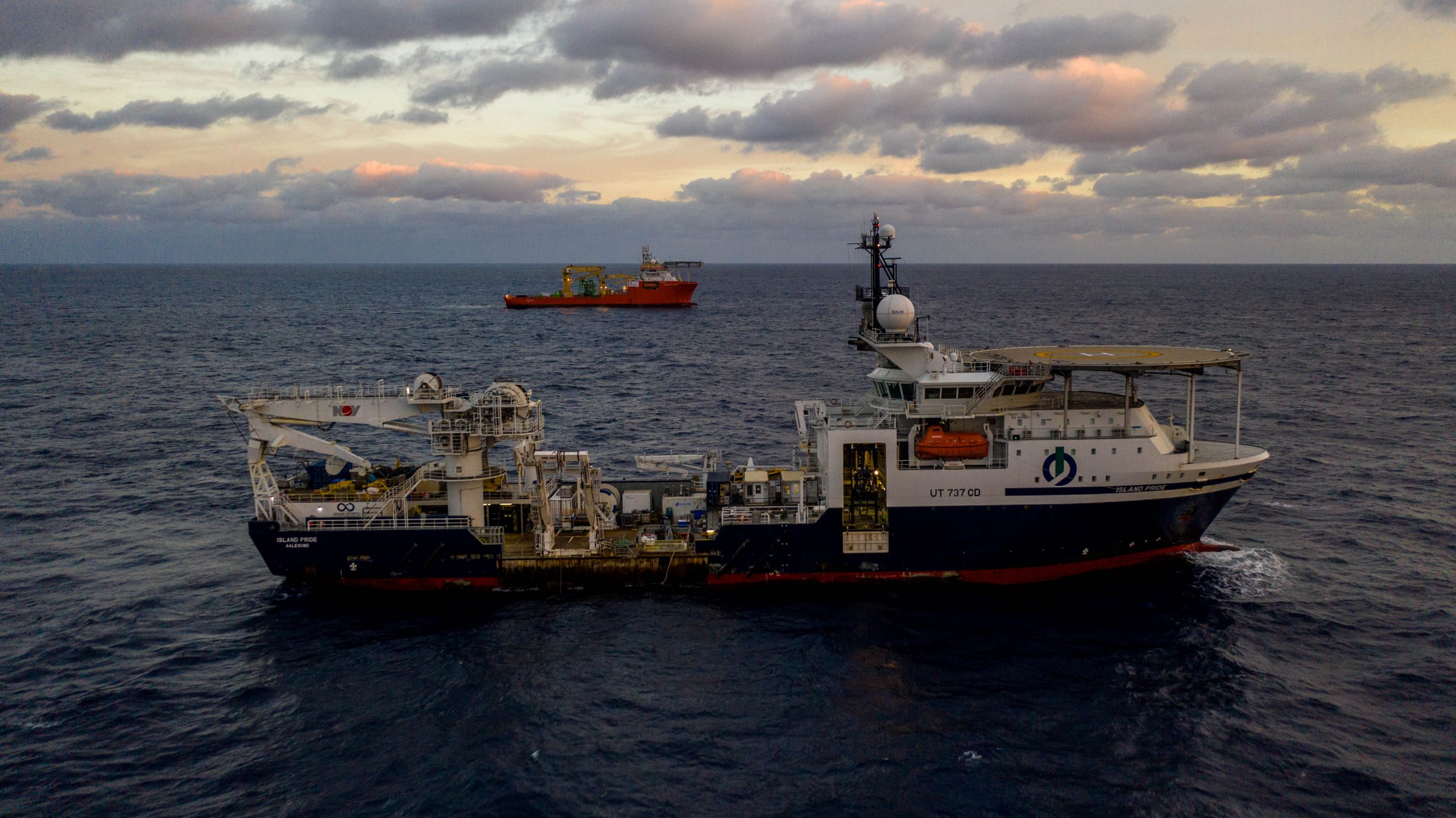
Deep seabed mining exploratory mission begins today
April 6, 2021
COMPANY ANNOUNCEMENT
San Diego, CA, 6 April: Global Sea Mineral Resource (GSR) is pleased to announce that its latest deep seabed mining exploratory mission begins today.
Over the next four weeks the company will be conducting trials in part of the Clarion Clipperton Zone (CCZ). The CCZ is a six million square kilometre region of the Pacific Ocean between Mexico and Hawaii.
GSR is collaborating with the European research project MiningImpact (1). Scientists from 29 European institutes will join efforts with the German exploration contract holder, BGR (Federal Institute for Geosciences and Natural Resources), to independently monitor the trials to help understand the environmental effects of collecting mineral resources from the seafloor.
 In view of potential at-sea protests by Greenpeace during the trials, Kris van Nijen, Managing Director of GSR said:
“Deep seabed mining is not settled science. There are gaps in knowledge and until these gaps are addressed it is not possible for final conclusions to be drawn about the appropriateness or otherwise of obtaining minerals from the seabed. Independent scientific research into the environmental effects of deep seabed mining is essential for good decision-making and well-informed regulation.
“Deep seabed mining may or may not represent one of the more responsible ways to source the metals the planet needs. Without continued research we will never know the answer. We ask only that the research be allowed to continue so that evidence-based decisions can be made.
“GSR will only apply for a mining contract if the science shows that, from an environmental and social perspective, the seabed can be a responsible source of the primary metals needed for population growth, urbanisation and clean energy transition.”
During the trial, GSR will be testing its pre-prototype seafloor nodule collector, Patania II, a 25-ton robot on caterpillar tracks. Patania II is equipped with the latest cameras and sensors, including environmental sensors. The robot is controlled from a surface vessel via a 5 km-long umbilical that provides power and communication capabilities.
The trial will aim to confirm the trafficability and manoeuvrability of Patania II and its ability to pick up nodules. Following a successful trial, GSR will go on to design and build a full-scale nodule collector with a riser and lift system to bring the nodules to a surface vessel during a system integration test.
Environmental monitoring is a key component of GSR’s development program, ensuring the effects of its activities are understood, can be accurately predicted and improved upon and can lead to the development and implementation of appropriate environmental management strategies.
GSR acknowledges that before any deep seabed mining occurs, it needs to be clearly demonstrated that such activities can be managed in a way that ensures the effective protection of the marine environment. Deep seabed mining is an industry in the exploration, research and development phase. Years of detailed scientific work lie ahead before there is any prospect of commercial activity.
Regulation
Never before has so much thought gone into regulating an industry before it even exists. No State or entity can commercially explore the seabed or collect nodules except under contract with the International Seabed Authority (ISA).
The ISA, established in 1994, is mandated through the UN Convention on the Law of the Sea (UNCLOS) to organize, regulate and control all mineral-related activities in the international seabed area and for the benefit of humankind as a whole.
To date, the ISA has awarded 18 exploration contracts in the CCZ. The contractors who hold these 15-year licenses represent nations including China, Japan, Russia, France, UK, Korea, Germany, Poland, Cook Islands, Nauru and Belgium. All exploration contract holders are undertaking geological and environmental studies as part of their contractual obligations.
The ISA is in the process of developing regulations for commercial activity and any contractors wishing to undertake mining operations in the international deep seabed area will need to abide by these strict regulations.
The regulations incorporate specific provisions to ensure the effective protection of the marine environment and conservation of marine biodiversity, human health and safety, and a system of payments which aims to ensure the equitable sharing of financial and other economic benefits derived from seabed minerals. The regulations must be agreed and adopted by the ISA Council and approved by the ISA Assembly, comprised of 167 Member States and the European Union.
Demand for metals
Trillions of rock-like accretions called polymetallic nodules lie at a water depth of between 4,000 and 6,000 metres on the seafloor of the CCZ.
Since the early 1970s, there has been growing interest in collecting these nodules due the high-grade and multiple metals they contain – metals like nickel, cobalt, manganese, and copper.
The metals found in polymetallic nodules are critical for clean energy technologies and urban infrastructure. In the long-term, a fully circular economy in metals is achievable but all credible studies (2) indicate that enormous quantities of primary resource will be required first.
Land-based reserves will not be able to meet demand, while recycling will only make a modest contribution because of long in-use lifetimes, among other factors.
Compared with the alternative, which is to rely exclusively on current and new land-based mines, the deep sea may present a more responsible way of sourcing the metals the planet needs for decarbonisation and sustainable economic development. Seabed minerals could diversify metal supplies and it could provide an option that does not involve deforestation, relocation of peoples, child labour and mountains of waste.
MiningImpact research
Trials of GSR’s Patania II pre-prototype nodule collector will take place in the Belgian and German contract areas of the CCZ. The studies being conducted by independent scientists in the MiningImpact consortium will not only address the direct effects of collecting polymetallic nodules, but also those of the sediment plume created by the process. The data will provide information on ecosystem effects of potential future mining that cannot be drawn from the small-scale experiments conducted in the past.
By employing state-of-the-art scientific equipment researchers will be able to determine the spread of the sediment plume and how it resettles. They will also be able to survey the loss of biodiversity across different faunal classes.
Among the specialized instruments that will be deployed are two remotely-operated vehicles (ROV), an autonomous underwater vehicle (AUV), in situ oxygen profilers and experiment chambers, in situ pumps, as well as 50 inter-calibrated hydro-acoustic and optical sensors for measuring the suspended sediment concentrations and particle sizes.
ENDS
(1) 29 institutions from nine European countries, plus the International Seabed Authority, are partners in MiningImpact. Twenty three scientists from eight of these institutions are on board the vessel monitoring the Patania II trial
(2) Institute for Sustainable Futures – Responsible Minerals Sourcing for Renewable Energy, 2019; Minerals for Climate Action: The Mineral Intensity of the Clean Energy Transition, World Bank, 2020; Analysis of Potential for Critical Metal Resource Constraints in the International Energy Agency’s Long-Term Low-Carbon Energy Scenarios. Watari et al.,2018
In view of potential at-sea protests by Greenpeace during the trials, Kris van Nijen, Managing Director of GSR said:
“Deep seabed mining is not settled science. There are gaps in knowledge and until these gaps are addressed it is not possible for final conclusions to be drawn about the appropriateness or otherwise of obtaining minerals from the seabed. Independent scientific research into the environmental effects of deep seabed mining is essential for good decision-making and well-informed regulation.
“Deep seabed mining may or may not represent one of the more responsible ways to source the metals the planet needs. Without continued research we will never know the answer. We ask only that the research be allowed to continue so that evidence-based decisions can be made.
“GSR will only apply for a mining contract if the science shows that, from an environmental and social perspective, the seabed can be a responsible source of the primary metals needed for population growth, urbanisation and clean energy transition.”
During the trial, GSR will be testing its pre-prototype seafloor nodule collector, Patania II, a 25-ton robot on caterpillar tracks. Patania II is equipped with the latest cameras and sensors, including environmental sensors. The robot is controlled from a surface vessel via a 5 km-long umbilical that provides power and communication capabilities.
The trial will aim to confirm the trafficability and manoeuvrability of Patania II and its ability to pick up nodules. Following a successful trial, GSR will go on to design and build a full-scale nodule collector with a riser and lift system to bring the nodules to a surface vessel during a system integration test.
Environmental monitoring is a key component of GSR’s development program, ensuring the effects of its activities are understood, can be accurately predicted and improved upon and can lead to the development and implementation of appropriate environmental management strategies.
GSR acknowledges that before any deep seabed mining occurs, it needs to be clearly demonstrated that such activities can be managed in a way that ensures the effective protection of the marine environment. Deep seabed mining is an industry in the exploration, research and development phase. Years of detailed scientific work lie ahead before there is any prospect of commercial activity.
Regulation
Never before has so much thought gone into regulating an industry before it even exists. No State or entity can commercially explore the seabed or collect nodules except under contract with the International Seabed Authority (ISA).
The ISA, established in 1994, is mandated through the UN Convention on the Law of the Sea (UNCLOS) to organize, regulate and control all mineral-related activities in the international seabed area and for the benefit of humankind as a whole.
To date, the ISA has awarded 18 exploration contracts in the CCZ. The contractors who hold these 15-year licenses represent nations including China, Japan, Russia, France, UK, Korea, Germany, Poland, Cook Islands, Nauru and Belgium. All exploration contract holders are undertaking geological and environmental studies as part of their contractual obligations.
The ISA is in the process of developing regulations for commercial activity and any contractors wishing to undertake mining operations in the international deep seabed area will need to abide by these strict regulations.
The regulations incorporate specific provisions to ensure the effective protection of the marine environment and conservation of marine biodiversity, human health and safety, and a system of payments which aims to ensure the equitable sharing of financial and other economic benefits derived from seabed minerals. The regulations must be agreed and adopted by the ISA Council and approved by the ISA Assembly, comprised of 167 Member States and the European Union.
Demand for metals
Trillions of rock-like accretions called polymetallic nodules lie at a water depth of between 4,000 and 6,000 metres on the seafloor of the CCZ.
Since the early 1970s, there has been growing interest in collecting these nodules due the high-grade and multiple metals they contain – metals like nickel, cobalt, manganese, and copper.
The metals found in polymetallic nodules are critical for clean energy technologies and urban infrastructure. In the long-term, a fully circular economy in metals is achievable but all credible studies (2) indicate that enormous quantities of primary resource will be required first.
Land-based reserves will not be able to meet demand, while recycling will only make a modest contribution because of long in-use lifetimes, among other factors.
Compared with the alternative, which is to rely exclusively on current and new land-based mines, the deep sea may present a more responsible way of sourcing the metals the planet needs for decarbonisation and sustainable economic development. Seabed minerals could diversify metal supplies and it could provide an option that does not involve deforestation, relocation of peoples, child labour and mountains of waste.
MiningImpact research
Trials of GSR’s Patania II pre-prototype nodule collector will take place in the Belgian and German contract areas of the CCZ. The studies being conducted by independent scientists in the MiningImpact consortium will not only address the direct effects of collecting polymetallic nodules, but also those of the sediment plume created by the process. The data will provide information on ecosystem effects of potential future mining that cannot be drawn from the small-scale experiments conducted in the past.
By employing state-of-the-art scientific equipment researchers will be able to determine the spread of the sediment plume and how it resettles. They will also be able to survey the loss of biodiversity across different faunal classes.
Among the specialized instruments that will be deployed are two remotely-operated vehicles (ROV), an autonomous underwater vehicle (AUV), in situ oxygen profilers and experiment chambers, in situ pumps, as well as 50 inter-calibrated hydro-acoustic and optical sensors for measuring the suspended sediment concentrations and particle sizes.
ENDS
(1) 29 institutions from nine European countries, plus the International Seabed Authority, are partners in MiningImpact. Twenty three scientists from eight of these institutions are on board the vessel monitoring the Patania II trial
(2) Institute for Sustainable Futures – Responsible Minerals Sourcing for Renewable Energy, 2019; Minerals for Climate Action: The Mineral Intensity of the Clean Energy Transition, World Bank, 2020; Analysis of Potential for Critical Metal Resource Constraints in the International Energy Agency’s Long-Term Low-Carbon Energy Scenarios. Watari et al.,2018
 In view of potential at-sea protests by Greenpeace during the trials, Kris van Nijen, Managing Director of GSR said:
“Deep seabed mining is not settled science. There are gaps in knowledge and until these gaps are addressed it is not possible for final conclusions to be drawn about the appropriateness or otherwise of obtaining minerals from the seabed. Independent scientific research into the environmental effects of deep seabed mining is essential for good decision-making and well-informed regulation.
“Deep seabed mining may or may not represent one of the more responsible ways to source the metals the planet needs. Without continued research we will never know the answer. We ask only that the research be allowed to continue so that evidence-based decisions can be made.
“GSR will only apply for a mining contract if the science shows that, from an environmental and social perspective, the seabed can be a responsible source of the primary metals needed for population growth, urbanisation and clean energy transition.”
During the trial, GSR will be testing its pre-prototype seafloor nodule collector, Patania II, a 25-ton robot on caterpillar tracks. Patania II is equipped with the latest cameras and sensors, including environmental sensors. The robot is controlled from a surface vessel via a 5 km-long umbilical that provides power and communication capabilities.
The trial will aim to confirm the trafficability and manoeuvrability of Patania II and its ability to pick up nodules. Following a successful trial, GSR will go on to design and build a full-scale nodule collector with a riser and lift system to bring the nodules to a surface vessel during a system integration test.
Environmental monitoring is a key component of GSR’s development program, ensuring the effects of its activities are understood, can be accurately predicted and improved upon and can lead to the development and implementation of appropriate environmental management strategies.
GSR acknowledges that before any deep seabed mining occurs, it needs to be clearly demonstrated that such activities can be managed in a way that ensures the effective protection of the marine environment. Deep seabed mining is an industry in the exploration, research and development phase. Years of detailed scientific work lie ahead before there is any prospect of commercial activity.
Regulation
Never before has so much thought gone into regulating an industry before it even exists. No State or entity can commercially explore the seabed or collect nodules except under contract with the International Seabed Authority (ISA).
The ISA, established in 1994, is mandated through the UN Convention on the Law of the Sea (UNCLOS) to organize, regulate and control all mineral-related activities in the international seabed area and for the benefit of humankind as a whole.
To date, the ISA has awarded 18 exploration contracts in the CCZ. The contractors who hold these 15-year licenses represent nations including China, Japan, Russia, France, UK, Korea, Germany, Poland, Cook Islands, Nauru and Belgium. All exploration contract holders are undertaking geological and environmental studies as part of their contractual obligations.
The ISA is in the process of developing regulations for commercial activity and any contractors wishing to undertake mining operations in the international deep seabed area will need to abide by these strict regulations.
The regulations incorporate specific provisions to ensure the effective protection of the marine environment and conservation of marine biodiversity, human health and safety, and a system of payments which aims to ensure the equitable sharing of financial and other economic benefits derived from seabed minerals. The regulations must be agreed and adopted by the ISA Council and approved by the ISA Assembly, comprised of 167 Member States and the European Union.
Demand for metals
Trillions of rock-like accretions called polymetallic nodules lie at a water depth of between 4,000 and 6,000 metres on the seafloor of the CCZ.
Since the early 1970s, there has been growing interest in collecting these nodules due the high-grade and multiple metals they contain – metals like nickel, cobalt, manganese, and copper.
The metals found in polymetallic nodules are critical for clean energy technologies and urban infrastructure. In the long-term, a fully circular economy in metals is achievable but all credible studies (2) indicate that enormous quantities of primary resource will be required first.
Land-based reserves will not be able to meet demand, while recycling will only make a modest contribution because of long in-use lifetimes, among other factors.
Compared with the alternative, which is to rely exclusively on current and new land-based mines, the deep sea may present a more responsible way of sourcing the metals the planet needs for decarbonisation and sustainable economic development. Seabed minerals could diversify metal supplies and it could provide an option that does not involve deforestation, relocation of peoples, child labour and mountains of waste.
MiningImpact research
Trials of GSR’s Patania II pre-prototype nodule collector will take place in the Belgian and German contract areas of the CCZ. The studies being conducted by independent scientists in the MiningImpact consortium will not only address the direct effects of collecting polymetallic nodules, but also those of the sediment plume created by the process. The data will provide information on ecosystem effects of potential future mining that cannot be drawn from the small-scale experiments conducted in the past.
By employing state-of-the-art scientific equipment researchers will be able to determine the spread of the sediment plume and how it resettles. They will also be able to survey the loss of biodiversity across different faunal classes.
Among the specialized instruments that will be deployed are two remotely-operated vehicles (ROV), an autonomous underwater vehicle (AUV), in situ oxygen profilers and experiment chambers, in situ pumps, as well as 50 inter-calibrated hydro-acoustic and optical sensors for measuring the suspended sediment concentrations and particle sizes.
ENDS
(1) 29 institutions from nine European countries, plus the International Seabed Authority, are partners in MiningImpact. Twenty three scientists from eight of these institutions are on board the vessel monitoring the Patania II trial
(2) Institute for Sustainable Futures – Responsible Minerals Sourcing for Renewable Energy, 2019; Minerals for Climate Action: The Mineral Intensity of the Clean Energy Transition, World Bank, 2020; Analysis of Potential for Critical Metal Resource Constraints in the International Energy Agency’s Long-Term Low-Carbon Energy Scenarios. Watari et al.,2018
In view of potential at-sea protests by Greenpeace during the trials, Kris van Nijen, Managing Director of GSR said:
“Deep seabed mining is not settled science. There are gaps in knowledge and until these gaps are addressed it is not possible for final conclusions to be drawn about the appropriateness or otherwise of obtaining minerals from the seabed. Independent scientific research into the environmental effects of deep seabed mining is essential for good decision-making and well-informed regulation.
“Deep seabed mining may or may not represent one of the more responsible ways to source the metals the planet needs. Without continued research we will never know the answer. We ask only that the research be allowed to continue so that evidence-based decisions can be made.
“GSR will only apply for a mining contract if the science shows that, from an environmental and social perspective, the seabed can be a responsible source of the primary metals needed for population growth, urbanisation and clean energy transition.”
During the trial, GSR will be testing its pre-prototype seafloor nodule collector, Patania II, a 25-ton robot on caterpillar tracks. Patania II is equipped with the latest cameras and sensors, including environmental sensors. The robot is controlled from a surface vessel via a 5 km-long umbilical that provides power and communication capabilities.
The trial will aim to confirm the trafficability and manoeuvrability of Patania II and its ability to pick up nodules. Following a successful trial, GSR will go on to design and build a full-scale nodule collector with a riser and lift system to bring the nodules to a surface vessel during a system integration test.
Environmental monitoring is a key component of GSR’s development program, ensuring the effects of its activities are understood, can be accurately predicted and improved upon and can lead to the development and implementation of appropriate environmental management strategies.
GSR acknowledges that before any deep seabed mining occurs, it needs to be clearly demonstrated that such activities can be managed in a way that ensures the effective protection of the marine environment. Deep seabed mining is an industry in the exploration, research and development phase. Years of detailed scientific work lie ahead before there is any prospect of commercial activity.
Regulation
Never before has so much thought gone into regulating an industry before it even exists. No State or entity can commercially explore the seabed or collect nodules except under contract with the International Seabed Authority (ISA).
The ISA, established in 1994, is mandated through the UN Convention on the Law of the Sea (UNCLOS) to organize, regulate and control all mineral-related activities in the international seabed area and for the benefit of humankind as a whole.
To date, the ISA has awarded 18 exploration contracts in the CCZ. The contractors who hold these 15-year licenses represent nations including China, Japan, Russia, France, UK, Korea, Germany, Poland, Cook Islands, Nauru and Belgium. All exploration contract holders are undertaking geological and environmental studies as part of their contractual obligations.
The ISA is in the process of developing regulations for commercial activity and any contractors wishing to undertake mining operations in the international deep seabed area will need to abide by these strict regulations.
The regulations incorporate specific provisions to ensure the effective protection of the marine environment and conservation of marine biodiversity, human health and safety, and a system of payments which aims to ensure the equitable sharing of financial and other economic benefits derived from seabed minerals. The regulations must be agreed and adopted by the ISA Council and approved by the ISA Assembly, comprised of 167 Member States and the European Union.
Demand for metals
Trillions of rock-like accretions called polymetallic nodules lie at a water depth of between 4,000 and 6,000 metres on the seafloor of the CCZ.
Since the early 1970s, there has been growing interest in collecting these nodules due the high-grade and multiple metals they contain – metals like nickel, cobalt, manganese, and copper.
The metals found in polymetallic nodules are critical for clean energy technologies and urban infrastructure. In the long-term, a fully circular economy in metals is achievable but all credible studies (2) indicate that enormous quantities of primary resource will be required first.
Land-based reserves will not be able to meet demand, while recycling will only make a modest contribution because of long in-use lifetimes, among other factors.
Compared with the alternative, which is to rely exclusively on current and new land-based mines, the deep sea may present a more responsible way of sourcing the metals the planet needs for decarbonisation and sustainable economic development. Seabed minerals could diversify metal supplies and it could provide an option that does not involve deforestation, relocation of peoples, child labour and mountains of waste.
MiningImpact research
Trials of GSR’s Patania II pre-prototype nodule collector will take place in the Belgian and German contract areas of the CCZ. The studies being conducted by independent scientists in the MiningImpact consortium will not only address the direct effects of collecting polymetallic nodules, but also those of the sediment plume created by the process. The data will provide information on ecosystem effects of potential future mining that cannot be drawn from the small-scale experiments conducted in the past.
By employing state-of-the-art scientific equipment researchers will be able to determine the spread of the sediment plume and how it resettles. They will also be able to survey the loss of biodiversity across different faunal classes.
Among the specialized instruments that will be deployed are two remotely-operated vehicles (ROV), an autonomous underwater vehicle (AUV), in situ oxygen profilers and experiment chambers, in situ pumps, as well as 50 inter-calibrated hydro-acoustic and optical sensors for measuring the suspended sediment concentrations and particle sizes.
ENDS
(1) 29 institutions from nine European countries, plus the International Seabed Authority, are partners in MiningImpact. Twenty three scientists from eight of these institutions are on board the vessel monitoring the Patania II trial
(2) Institute for Sustainable Futures – Responsible Minerals Sourcing for Renewable Energy, 2019; Minerals for Climate Action: The Mineral Intensity of the Clean Energy Transition, World Bank, 2020; Analysis of Potential for Critical Metal Resource Constraints in the International Energy Agency’s Long-Term Low-Carbon Energy Scenarios. Watari et al.,2018 